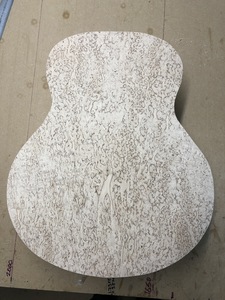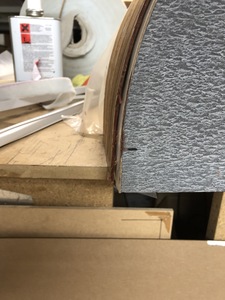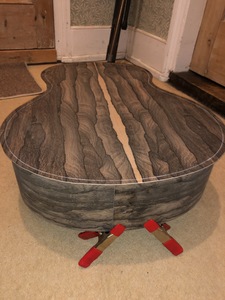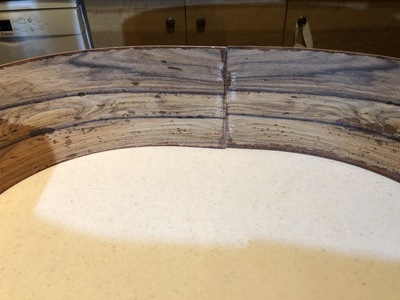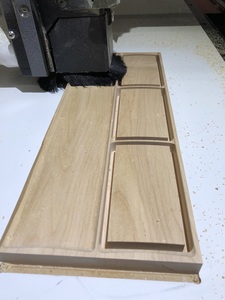Having got bored waiting for my my bending iron to arrive and having read some articles and watched some videos where laminated backs and sides were actually put forward as having some distinct benefits I decided to have a go. I decided to go for a West System glue up rather than water based as putting that much moisture into such a thin lamination just doesn’t seem like a good idea to me.
I am making two sets, one in Santos Rosewood and one in Ziracote. Both sets are made up of four layers of 0.6mm (nom) veneer. The Santos back has got two layers of mahogany with Santos on either side and the Ziracote has got two layers in maple as a core. All the face and core veneers have been edge glue stitched prior to lamination and the grain of the core runs at 90 degrees to that of the outer layers and the glue joints have been staggered.
The moulds were made from CNC hotwire cut extruded polystyrene and the parts were vacuum pressed at 9.9 tonnes per m2 for a minimum of 6 hours. All good so far!
The backs have come out of the press but the first set of sides have been left in overnight to ensure a full cure of the West System epoxy. The Ziraote sides will be in tomoroow morning. The one advantage of using out of date West System is that the hardener goes dark which makes it easier to spread evenly. Don’t use it on figured sycamore though!!
In using knife cut veneers rather than saw cut solid you do end up with a perfect book match joint. Here are some pics of the processes so far. Love to hear any thoughts or comments
Holy Moly Darren - Amazing pics - Great work!
The original Maccaferri Guitars were made this way so why not - I call it posh plywood.
It should be stiffer and stronger - both good things - Just have to be very careful when sanding...
It is not the easiest way to go which is why it is not recommended on the course - but interesting to experiment with different tonewoods.
Speaking of which...Where are you getting that lovely wood from? and how thick are the Veneers?
Measure twice, cut once...
Hi Mark and thank you for your feedback,
The laminated sides have turned out better than I could have hoped. They have sprung by about 0.5mm from the mould ie not at all and, other than a bit of epoxy squeeze through that needed to be sanded off they are just about perfect. All of the veneers used were standar 0.5-0.6mm thick so with the two outer show layers and the two core layers of maple or mahogany they were coming out of the press at around 2.3mm thick and after sanding ended up at 2mm or just under. They sound really nice and hard and have a good resonance (at least to my ear). The mahogany core back sounds a little deeper and less ‘ringy’ than the laminations with maple core layers so it will be interesting to see if this translates into any noticeable difference in the sound of the instruments.
I have three sets completed in Santos rosewood, ziracote and massur birch (how pretty is that?!) and I have one more set to make over the weekend in a species not yet decided. It will be something you haven’t seen before though I think.
Here are some pics of the progress since last time.
Hi again,
there’s one other point that is worth making regards using laminated backs and sides. I don’t bang on about eco topics very often (FSC requirements are a constant pain in my day job!) but using knife cut veneers rather than saw cut solid timber is a much more efficient way to use increasingly scarce materials. You can get 4 to 5 x as many sets of backs and sides out of the same volume of material if used as a veneer compared to solid timber. I would never suggest that the quality of instruments be compromised but if we can find a way to produce guitars that sound as good but use these materials more efficiently then isn’t this a good aim? We are undoubtably going to have to regularly consider these isssues as more species get added to the CITES lists so it may end up being simple economics that forces the issue. Think about this. Ziracote solid back and side sets £300-£350. Ziracote veneer £45-£50m2. Even if you use it on both sides (not strictly necessary I think and certainly not book matched! ) then veneered laminated parts start to look very cost effective. This construction also opens up the opportunity to use species that just are not available, or suitable, to be used as solid. The masssur birch in the previous photos being a good case in point.
I source most of my veneers from Capital Crispin in London. I first bought veneer from Crispins as a student in 1984 when they were based in Curtain Road in Shoreditch and they are some of the nicest people in the business. You can buy single leaves from them if you need to but you will pay a premium over the rate charged for full bundles.
I will post some more pics once something else interesting has happened (and I don’t mean Brexit!!)
Regards
Darren
I source most of my veneers from Capital Crispin in London. I first bought veneer from Crispins as a student in 1984 when they were based in Curtain Road in Shoreditch and they are some of the nicest people in the business. You can buy single leaves from them if you need to but you will pay a premium over the rate charged for full bundles.
Awesome Darren - Thanks for sharing that!
Looking forward to seeing how they progress...
I think we'd all also love to know where you get the vacuum pump and bags from!?
This is for sure a very good way to go especially nowadays with exotics becoming more expensive and rare by the day...
Alas - probably not for the beginner though - I think it is still a lot easier and cheaper to go down the standard 'bending iron' route for most.
Measure twice, cut once...
Hi again,
So, another weekend of work and a few more steps of progress. I have made an external mould with expanding internal clamps and have machined the neck and bottom blocks from maple. I have cut the massur birch sides to length, planed the front edges flush with the mould and glued in the maple blocks. The kerfed strips have been bonded and trimmed and the bottom block chamfered to keep it away from the soundboard. The zircote sides have undergone the same process tonight, and tomorrow I plan to make the template to mark the sides for trimming ready to receive the kerfed strips and, eventually, the back. I am not sure if it would have been better to trim the sides roughly to shape before laminating but I’d always prefer to have excess material to remove than not enough! I have all of my soundboard struts cut so I guess that glueing this up is the next big step. Unfortunately I have got a lot of work on in the next week or two so progress is likely to slow. I hate it when work gets in the way of having a good time!
Vacuum laminating is a process I am very familiar with given that this is the business that I am in. In fact the main motivating force behind my decision to finally make a guitar was that I have recently supplied six soundboard presses to a well known guitar manufacturer in Northern Ireland and it just seemed crazy that I had never attempted to build an instrument myself.
I fully understand the commercial sensitivities of other people using your platform to promote their own businesses and I have no intention of doing so. I am very happy to keep posting pics and answering questions though.
When my bending iron turns up (anyone else had experience of The Luthier’s Bench customer service?) I will be following the more traditional method of construction for at least another one or two instruments and I am very interested to compare the results of both alternatives. (Still planning to rescue that solid ebony back)
All the best
Darren
Ok, so here’s a question. The massur birch parts don’t sound as hard and ringy as the ziracote, with the santos rosewood somewhere in the middle. Would it be better to match the massur birch with a very hard and high tone soundboard like a heat treated Sitka spruce rather than cedar, for example? I prefer a fairly base heavy guitar as I think it is easier to boost treble through an amp than create bass. Any ideas or suggestions gratefully received.
Darren
Hey Darren - I tend to try and balance the front with its back and sides...
for eg. I wouldn't put a super heavy back and sides with a super light top.
I try and match them roughly like this - the aim is for the back and front to work together to move as much air as possible so it helps if they are equally matched (ish)
Unfortunately guitarmaking is not an exact science so it is really hard to define exactly what does what...
You could try scalloping the top braces to enhance the bass?
Beautiful work Darren
I think the short answer is : I would put the Cedar with the Birch
But your guess is as good as mine 😉
Measure twice, cut once...
Thanks, I will do. My natural tendency is to prefer science to art but I guess I'm going to have to let go a bit on this one!
I have one cedar soundboard that seems very much floppier across the grain than the others. Is this necessarily a problem and will the bracing take care of it? If you think it better to avoid using it then I have others that are much stiffer in both axis.
My last sets of laminated sides! Promise! This time I have used the same veneer all the way through ie macassar ebony, with two internal layers running at 90 degrees. Not sure if this will make a difference but it means that I can say that they are macassar ebony all the way through. One thing that has been a revelation is that I used Dynea Prefere 4152 UF resin to bond these. This is a liquid resin with a powdered hardener and I also added an extender powder (Prefere 5912) which helps prevent bleed through to the surface of the veneer (something that is a pain with West System). The mix ratio was 200/30/70 (resin/hardener/extender) and there is pretty much no bleed through at all which wil make sanding a lot quicker. A 300g mix was enough to comfortably bond a four layer back and two four layer sides without the need to scape the glue pot out. I did one set with the fast hardener (Prefere 5689) and one set with the medium hardener (Prefere 5602). They both worked but I think I would suggest using the medium in most cases as the fast was just getting a little too sticky for my liking by the time I was getting the last side glued up and the veneer was starting to cling to the roller. If committing to a 16-24 hour cure anyway then the medium will just make things a little more relaxed all round.
Sorry, I'm way late to this thread but was doing some research on laminated backs. was curious about how you seamed and joined the back pieces? what glue did you use? how'd you joint them to get a perfect seam? didn't notice any veneer tape.
thanks
sean
Hi Sean,
I’m pretty sure that there is a section of video in the laminating masterclass I filmed with Mark where I demonstrate the method used. If you imagine glueing the halves of a very thin soundboard together you’re pretty much there. Tape the two pieces of veneer together on one side with tape across the joint and then a piece the full length of the joint. Then fold the taped joint over and smear some glue along the exposed edge of the veneer. Fold the veneer back flat again and make sure the the leaves are meeting properly before taping the joint in the same way as the first side. Go over the joint again with a little roller and check again that everything is aligned. If you want to clamp it between a couple of bits of wood then you can, but I don’t usually bother. Leave for at least a couple of hours and then carefully remove the veneer tape, watching all the time for any grain starting to lift. If it does then change the direction in which you are pulling off the tape. Job done! I use a high grade PVA but avoid Titebond if joining light veneers such as maple or sycamore as it will stain them. The tape I use is a self adhesive plastic tape which leaves no residue but has enough stretch to allow the joint to be pulled together really nicely. Call me on the Bagpress number if you want some. Masking tape and the Stewmac orange or brown tapes have too thick an adhesive layer and are very prone to leaving residue so best not to use these and the old ‘lick and stick’ gummed tape will leave a visible shadow once lacquered so, again, avoid.
Hope this helps but let me know if I can help further.
Darren
@darrenking thanks, I am signing up for that course asap. im in the US so will have to look for the tape here.
@darrenking Wow! This is all truly amazing. I am stunned beyond belief, this is proper guitar building, not that crap I do. This is on a whole new level.
One day. ✊
Make guitars, not war 🌍✌️🎸
Hi @seanwhcraig, I am pretty certain that it is Tessa 4287 and you ideally want it in 19mm or 25mm (3/4" or 1"). You'll need one of those tape dispenser things as well and the rolls fit the StewMac three roll stands. Mind you fingers though, the StewMac product is great for lowering your blood pressure (if you know what I mean!)
Cheers
Darren
@darrenking thanks. i have a bunch of those tape dispensers. and i know how they can jump up and bite you 🙂





















